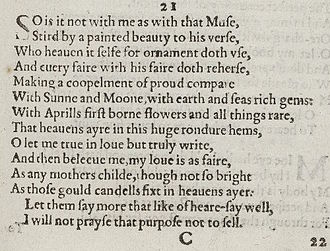Sonnet 21
Q1
Q2
Q3
C
So is it not with me as with that Muse
Stirr’d by a painted beauty to his verse,
Who heaven itself for ornament doth use
And every fair with his fair doth rehearse,
Making a couplement of proud compare,
With sun and moon, with earth and sea’s rich gems,
With April’s first-born flowers, and all things rare
That heaven’s air in this huge rondure hems.
O, let me, true in love, but truly write,
And then believe me, my love is as fair
As any mother’s child, though not so bright
As those gold candles fix’d in heaven’s air:
Let them say more that like of hearsay well;
I will not praise that purpose not to sell.
4
8
12
14
Sonnet 21 is one of 154 sonnets written by the English playwright and poet William Shakespeare and is part of the "fair youth" sequence. Like Sonnet 130, it addresses the issue of truth in love, as the speaker asserts that his lines, while less extravagant than those of other poets, are more truthful. Contrary to most of Shakespeare's sonnets, Sonnet 21 is not addressed to any one person. There is no second person, no overt "you" or "thou" expressed in it.
Sonnet 21 is a typical English or Shakespearean sonnet. It consists of three quatrains followed by a couplet, nominally rhyming abab cdcd efef gg — though this poem has six rhymes instead of seven because of the common sound used in rhymes c and f in the second and third quatrains: "compare", "rare", "fair", and "air".
The sixth line exemplifies a regular iambic pentameter:
A reader's sense of meter usually arises chiefly from stresses inherent in the text. Line ten provides a case in which the reader's sense of meter must condition the accents applied to the text. Without the benefit of reading ahead to the eleventh line, a neutral prose reading of second half of line 10 would observe stresses on the words "love" and "fair". However this does not produce a well-formed pentameter line. A sensitive reader will place an accent on "my" which in turn will allow ictuses to rest on "my" and "is", producing the well-formed iambic pentameter scanned below, even before the textual reason for the contrastive accent on "my" (as compared to "any mother's") is understood:
...
Wikipedia

